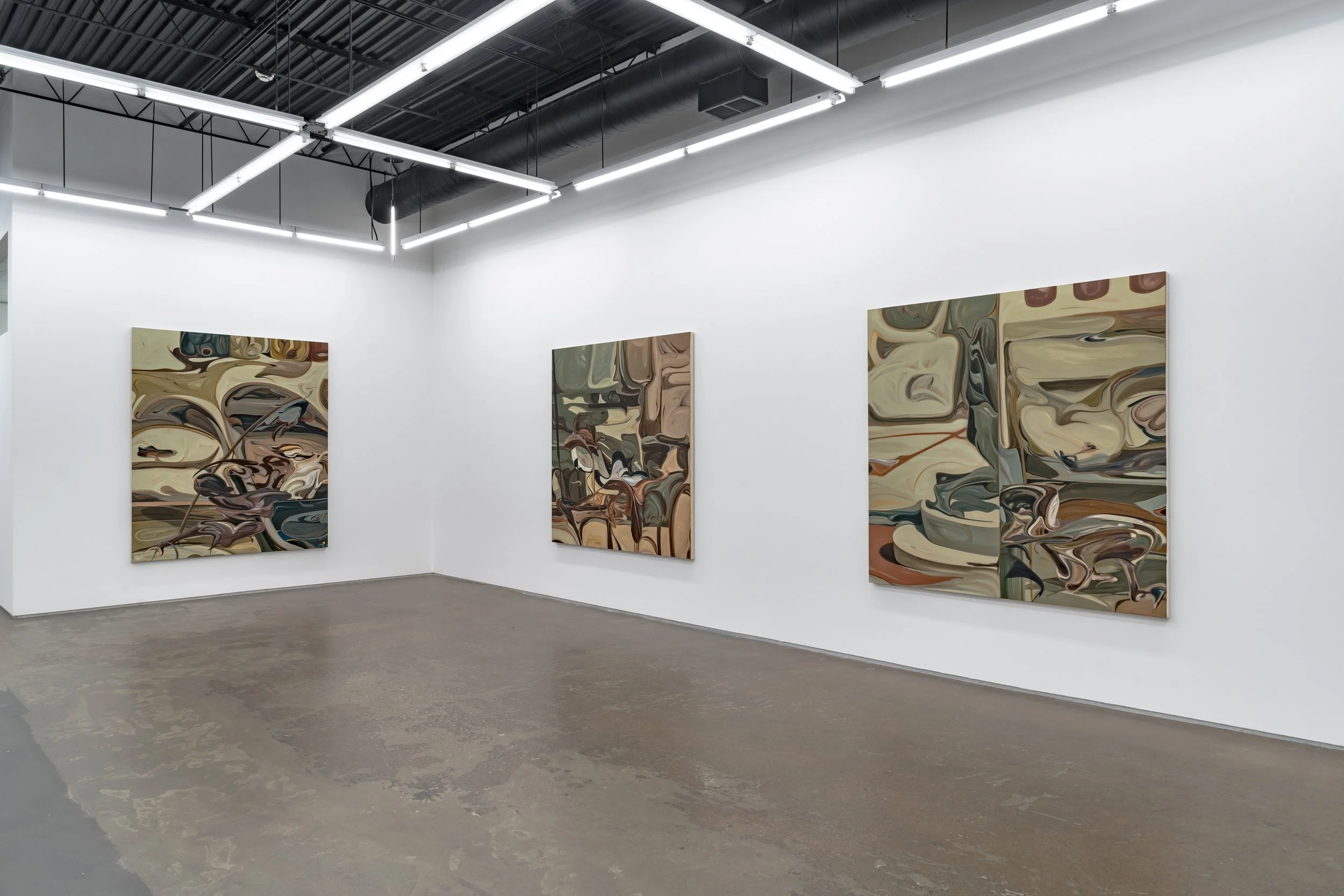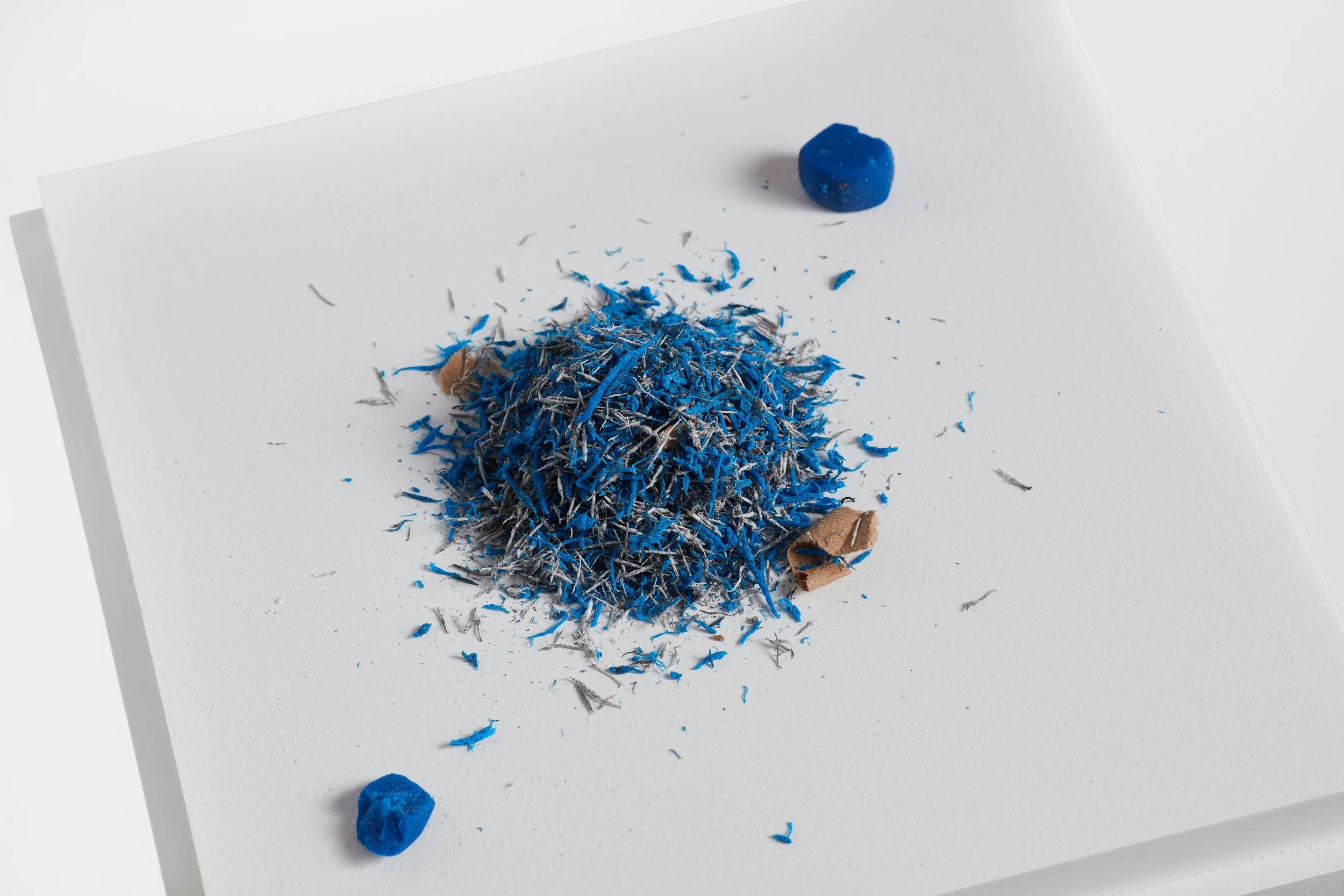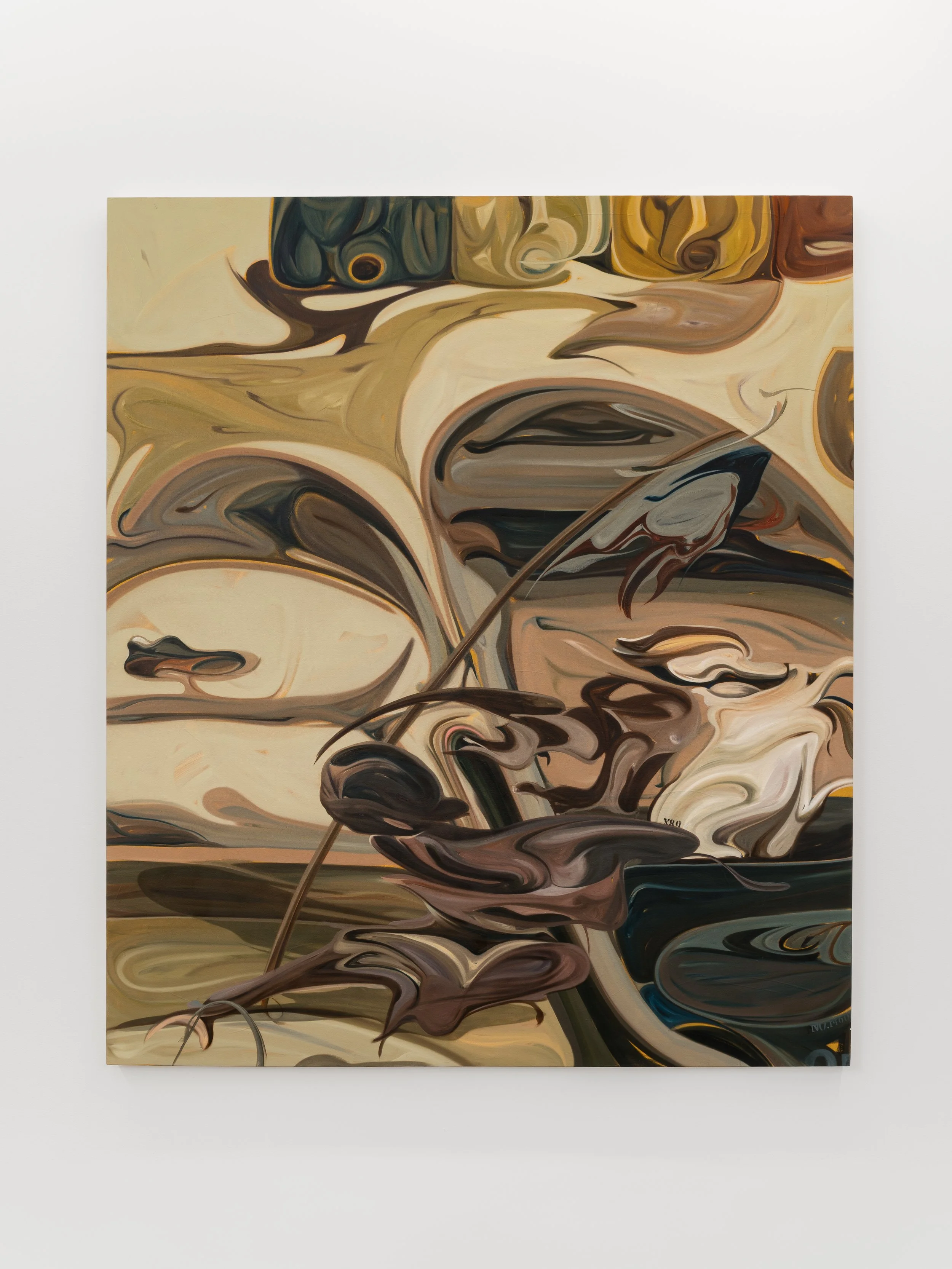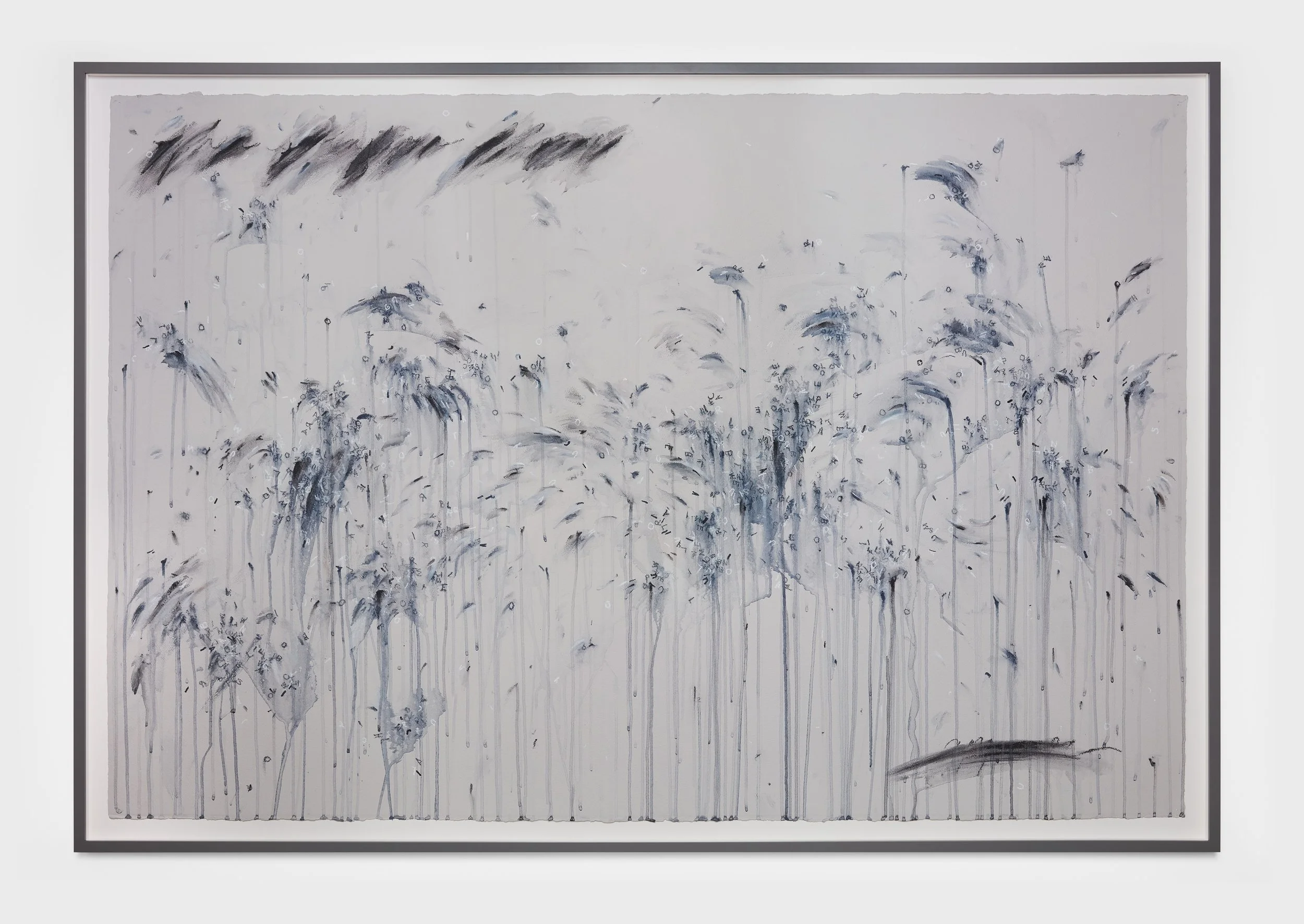Echoes of Subjectivity in Abstract and Surrealist Translation
Chicago calls out to the country, a stronghold of hope, acceptance, and protection—the largest midwestern city, a bastion of democratized politics. Artists and cultural institutions are beginning to echo this sentiment in their own translations. Language spoken across and again, increasingly visible, provides a foothold for more people to latch onto. Two exhibitions in the West Town neighborhood treat translation as a form of reinforcement: Luke Agada’s To Translate is to Move Across, presented at Monique Meloche Gallery, and Bethany Collins’s Dusk at Patron Gallery. Both solo shows spotlight the artist’s process as integral to their method, providing context in conceptualizing their relationship with their subjects. To view these shows is to read the personal through the lens of style, inviting a fluid understanding of fact that is always tainted with subjectivity.
Luke Agada’s Transfiguration series (2025) best shows his process of extrapolating meaning from objects through increasingly abstract depictions. Transfiguration (White Tulips), Transfiguration (Keg), and Transfiguration (MFL), each a charcoal triptych, read as stop motion sequences where the subjects flow out of their material form. Each follows a type of delusion built into its nature. This is most clear in the singularly text-based work, MFL, where the words “MOVE,” “FADE,” and “LOST” do exactly what they describe. Agada’s letters become playful characters, difficult to follow, but more striking are the subtle charcoal lines in the background that morph into shaded regions, while shadows realign and condense. In Keg, Agada splits a canister of gas over the course of the triptych, exploding the object’s individual elements into a multidimensional representation of its own assemblage. Through following the call of context, Agada’s work bridges the gap between denotation and form. His paintings are a visual study of material culture, filling in the fluid contours of situational drama from a pregnant psyche.
Mere blocks away, Bethany Collins’s Dusk utilizes selective retelling to depict the death of the empire. Her Loss series (2024–2025) recreates single pages from the classic American novel Moby Dick; or, The Whale, blown up to life size and furiously erased, leaving only a handful of phrases visible. What’s left is meditative poetry that recollects a tumultuous and all-powerful sea. Collins fights against the story, one taught through generations, smudging the ink and ripping the paper like an angry student attempting to comprehend the tome. Eraser fragments litter the bottom of the frame: evidence of her grapple. On nearby pillars, Collins displays sculptural mounds of the used blue erasers, whittled into oblivion. The remains are pyramids of the dusted artifacts of her process that transmute the text into meaning. In the final room, she leaves the final words from the last chapter, “then all collapsed, and the great shroud of the sea rolled on as it rolled five thousand years ago.” Collins’s work uses reinterpretation to extrapolate the immutable. What remains is none of the individual actors, but the environment that hosts them: persistent currents of culture. Through tedious reproduction, Dusk exhausts the American cannon and begs for a new order.
In Collins’s work, language is sticky; the reader is suspended in the turbulent waters between Collins’s reinterpretation and the original text. Her The Battle Hymn of the Republic (2024–2025) series repeats the same song, performed with various lyrics, rewritten to support different armies and causes over time. She writes each iteration of the song in wet cursive letters that drip down the painting or dark wax that she smudges. An army of individual printed letters floats in the background, while the words appear like eyes crying with smeared mascara. The original song is obscured through multiple translations, but all versions march soldiers to their graves. Interspersed in the first room at Patron are Collins’s graphite drawings of roses: bouquets adapted from lithographs at the Library of Congress, again smudged, erased, and speckled with black dust. An American symbol, reproduced in beautiful detail, their lives are devoid of color, like the ashy, washed remains that once burned bright. Dusk is told in blacks, whites, and blues, nauseatingly monotonous and feverishly restrained—it doesn’t go unnoticed that red, which would complete the American flag, is violently withheld.
The main room of Monique Meloche is full of large oil-washed still lifes in earth tones, distorted to the edge of recognition, seemingly the result of an overzealous fan of the Photoshop liquify tool. The color palettes and arching brushstrokes transform the gallery into a fertile mudbath, a safe enclave away from the mechanized grey grind of the city just outside. Agada, a Lagos-born Chicago transplant, investigates the social intertidal zones at the same time as the exhibition makes them. Works like Borderlands Mediation (2025), Compound Consciousness (2025), and Doors (2025) bear a dividing line that acts like a portal between sides. Shapes brush up to the crossing, caressing it, aching to stretch beyond. Gentle curves may eventually find passage through, while other sections of perpendicular lines rebound in sharp, chaotic explosions. The sides, loose mirrors of each other, are extensions of the same place, suspended in urgency to know itself. Curved shapes catch and droop to form sensual crevices that provoke fetishized objects and bodies at rest. In The Song and Dance After Crossing (2025), two forms embrace, Agada’s brush strokes wisp and wick away layers of paint to reveal subsections and build subtle texture. Basking under these rich colors, his paintings are decadent masterpieces that billow under a stagnant, almost repressive wind of social gaze. For Agada, the simple act of perception is also one of translation; he transcribes reality as it drips with meaning. His surrealist paintings are a curious breath for the public and private to collide in shared understanding, a window to graciously comprehend himself.
Chicago institutions nourish a cultural hunger, one nonspecific to native English speakers. Simultaneous to these gallery shows, the Museum of Contemporary Art is leading label translation efforts, providing guidelines for other museums on how to implement both English and Spanish descriptions. Just a few blocks away, downtown, the Poetry Foundation is also programming in multiple languages by partnering with the European Union National Institutes for Culture for readings in seven spoken languages, complete with ASL. Across the windy city, understanding is lingua franca, where ideas are accessible outside of English. While Agada and Collins still exclusively utilize English in their shows, their abstract translations animate their subjects into dramatic contextual rearrangements. The spaces of Monique Meloche and Patron Gallery resonate with the echoes of each artist as they transform stagnant forms into vibrant matter.
Luke Agada: To Translate is to Move Across is on view at Monique Meloche Gallery from September 20 through November 1, 2025.
Bethany Collins: Dusk is on view at Patron Gallery from September 11 through October 25, 2025.






